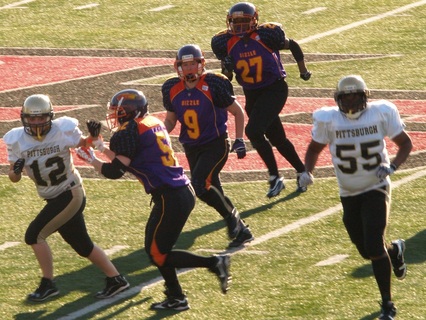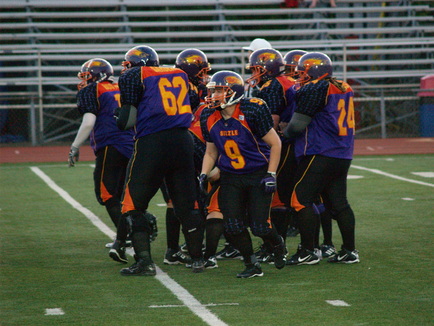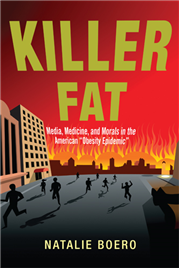Miami University – Hamilton
I never intended to play full-contact, tackle football. When I set out to examine the experiences of women playing football, a sport that is guided by a masculinized culture and still thought to be “for men,” my research plan was to participate and observe from the sideline. I expected to carry the water, fetch kicking tees, and hold footballs. But, as an athletic 30 year-old, my participants saw me as a potential player. To build rapport, and gather the best data, I had to play. Making the decision to play was a difficult one, though, because it meant exposing my body to all of the rigors of playing a physically-demanding contact sport. It also would become the best methodological decision I made throughout the research process.
In researching the physical body there is perhaps no better tool than participant observation. Certainly any activity or observational setting will be embodied in some way; even sitting behind a desk engages the body. However, becoming a full participant in a space where the body is leveraged as a specific tool of the trade can be especially enlightening. Ultimately, the engagement of my body in this research made the "absent body" (Leder 1990) present, illuminating the unique bodily experience of women playing tackle football.
As Leder (1990) notes, dys-appearance largely occurs when we experience pain or injury. One way the absent body becomes present through pain is in reminding us of the value of the appendage that is injured. For example, I never considered the complexity of the muscles surrounding my hip until I was injured during a football drill and suffered a "hip pointer." A hip pointer is when the bone and muscle on the iliac crest, or hip bone, are bruised. This injury occurs when the soft tissue and muscle on the hip bone are compressed into the bone. Hip pointers are common in football, due to the propensity for the hip to take direct hits during play (Moore, Dalley, and Agur 2010). I had never thought about the many muscles that attach to one another in that area. The injury caused a sharp pain that arose with nearly any movement. Even sneezing, coughing, or laughing caused excruciating pain. It was the pain, or dysfunction, that made this absent part of the body present.
Although Leder's (1990) main argument is that the absent body becomes present when it experiences pain, I would argue that there are other situations in which the absent body may present itself. Women become very aware of their bodies when preparing for and playing contact football. Training for the sport means gaining muscle and strength, while playing guarantees visible markers of its physicality, including bruises, scratches, and cuts. In this case the absent body becomes present due to "the gaze of the Other," or at least the potential gaze. This "social dys-appearance" alludes to the power discrepancies women experience due to ideological notions of the appropriately gendered body (Leder 1990). While bruises and injuries functioned as a “badge of honor” and proof of ones sacrifice to the team on the field, women were subject to a stigmatizing gaze off the field. A colleague of Audrey told her "there’s a place you can get help" after seeing bruises on her body. Shannon's large forearm bruises prompted a coworker to say "Shannon, you look disgusting." She responded, "this is normal," to which her coworker said "Yeah, sure Shannon, you’re normal," inciting laughter from all. One of my Sociology of Sports students, a university football player, stated he was sure I played football, "because those kinds of bruises only come from football." I wondered what other students thought. I had been asked about them many times, but only by people who knew I was playing football.
Bruises were not the only injuries that needed to be explained. As a rookie, Tammie broke a bone in her foot during a practice before she even had the opportunity to play in a game. Worried about being stigmatized at her place of employment, when she was asked if she broke her foot slipping on the ice, she agreed, allowing her coworkers to believe this was true. She said she did not want her coworkers to know that she played football, because she did not want to hear people say “I told you so” about getting injured while playing the sport. Although injuries are unavoidable within tackle football, injuries for women can be used as proof that female bodies are not equipped for such a demanding sport. In this case, both physical and social “dys-appearance” can serve to make the absent body present.
Embodied participant observation allows the researcher to gain a first-hand understanding of the corporeal engagement necessary in the site of research, and the meanings and significance of the physical body in interactions within that space. This may include gaining new skills (Lande 2007; O'Conner 2007), engaging in risk-taking behaviors that may lead to pain/injury (Aalten 2007; Sands 1999, 2002; Okley 2007; Wacquant 2004), or even death (Morris 1982). Full commitment of the body in the research process opens the researcher's body as a site for analysis that can directly address the bodily experience of the people being studied. In examining sports, especially contact sports, this allows for a deeper understanding of the impact these physically demanding activities can have on participants. I was aware of my body more while playing football than perhaps at any other point in my life; during those two years my body was often very present in my consciousness. As sociologists of the body, we have the ability to address the lack of “sufficient substantive investigations of the significance of the body to people’s daily lives," (Shilling 2007:13) and part of that may include using our own bodies as a source of knowledge.
References
Aalten, Anna. 2007. "Listening to the Dancer’s Body." The Sociological Review 55: 109–125.
Lande, Brian. 2007. "Breathing Like a Soldier: Culture Incarnate." The Sociological Review 55: 95–108.
Leder, Drew. 1990. The Absent Body. Chicago, IL: University of Chicago Press.
Moore, Keith L., Arthur F. Dalley, and A.M. Agur. 2010. Clinically Oriented Anatomy, 6th ed. Philadelphia, PA: Wolters Kluwer Health/Lippincott Williams & Wilkins.
Morris, Brian. 1982. Forest Traders: A Socio-economic Study of the Hill Pandaram. London: Athlone Press.
O'Connor, Erin. 2007. "Embodied Knowledge in Glassblowing: The Experience of Meaning and the Struggle Towards Proficiency." The Sociological Review 55: 126–141.
Okely, Judith. 2007. "Fieldwork Embodied." The Sociological Review 55: 65–79.
Sands, Robert R. 1999. Gutcheck!: An Anthropologist's Wild Ride Into the Heart of College Football. Carpinteria, CA: Rincon Hill Books.
Sands, Robert R. 2002. Sport Ethnography. Champaign, IL: Human Kinetics.
Shilling, Chris. 2007. “Sociology and the Body: Classical Traditions and New Agendas.” The Sociological Review 55: 1-18.
Wacquant, Loïc. 2004. Body & Soul: notebooks of an apprentice boxer. New York: Oxford University Press.



 RSS Feed
RSS Feed
